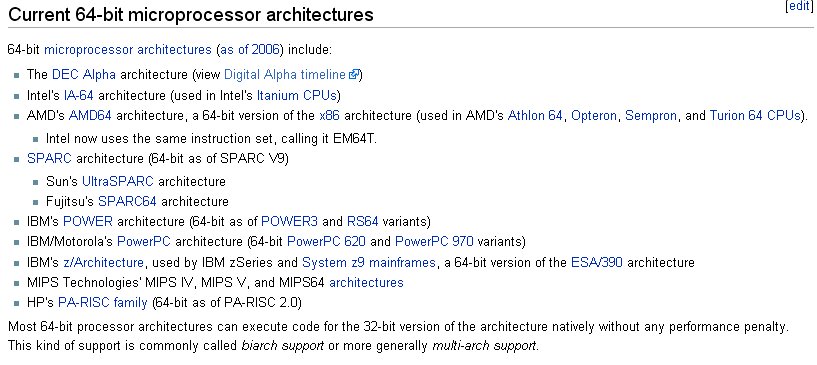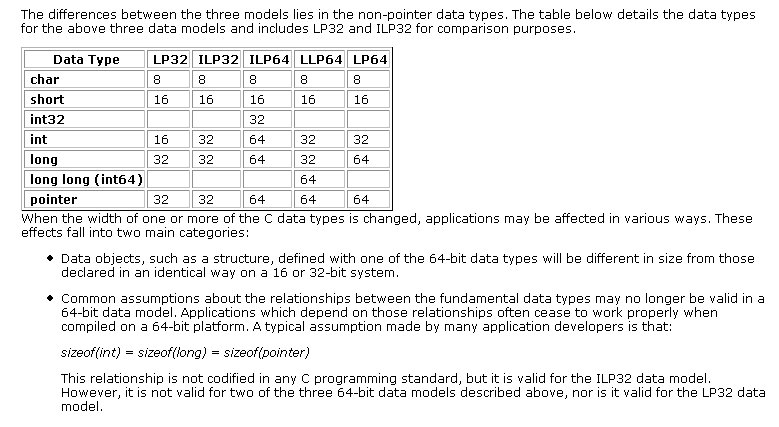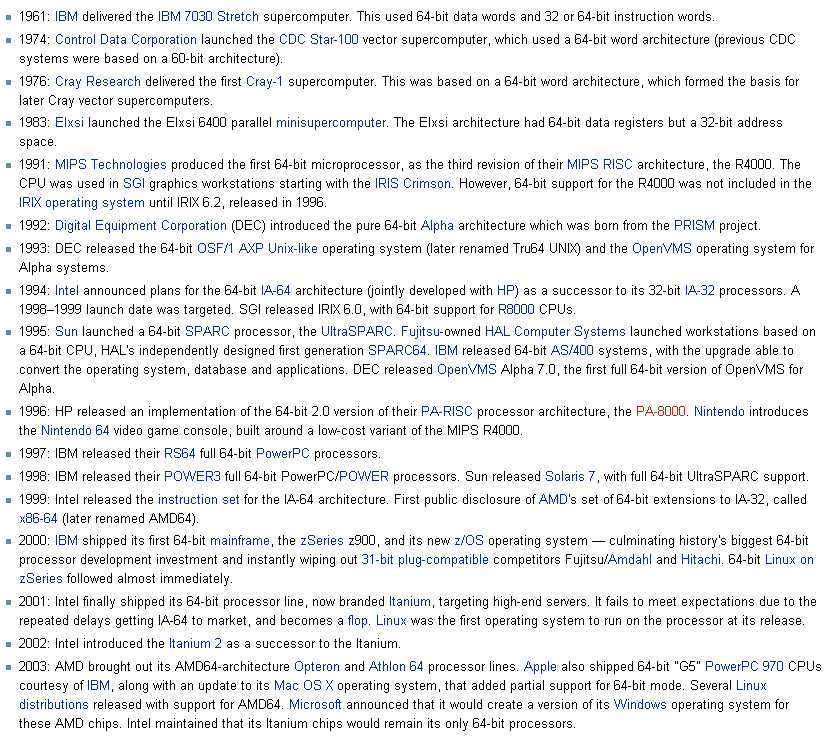<- previous index next ->
32-bit and 64-bit ALU architectures are available.
A 64-bit architecture, by definition, has 64-bit integer registers.
Many computers have had 64-bit IEEE floating point for many years.
The 64-bit machines have been around for a while as the Alpha and
PowerPC yet have become popular for the desktop with the Intel and
AMD 64-bit machines.
 Software has been dragging well behind computer architecture.
The chaos started in 1979 with the following "choices."
Software has been dragging well behind computer architecture.
The chaos started in 1979 with the following "choices."
 The full whitepaper www.unix.org/whitepapers/64bit.html
My desire is to have the compiler, linker and operating system be ILP64.
All my code would work fine. I make no assumptions about word length.
I use sizeof(int) sizeof(size_t) etc. when absolutely needed.
On my 8GB computer I use a single array of over 4GB thus the subscripts
must be 64-bit. The only option, I know of, for gcc is -m64 and that
just gives LP64. Yuk! I have to change my source code and use "long"
everywhere in place of "int". If you get the idea that I am angry with
the compiler vendors, you are correct!
The early 64-bit computers were:
DEC Alpha
DEC Alpha
IBM PowerPC
Some history of 64-bit computers:
The full whitepaper www.unix.org/whitepapers/64bit.html
My desire is to have the compiler, linker and operating system be ILP64.
All my code would work fine. I make no assumptions about word length.
I use sizeof(int) sizeof(size_t) etc. when absolutely needed.
On my 8GB computer I use a single array of over 4GB thus the subscripts
must be 64-bit. The only option, I know of, for gcc is -m64 and that
just gives LP64. Yuk! I have to change my source code and use "long"
everywhere in place of "int". If you get the idea that I am angry with
the compiler vendors, you are correct!
The early 64-bit computers were:
DEC Alpha
DEC Alpha
IBM PowerPC
Some history of 64-bit computers:
 Java for 64-bit, source compatible
Don't panic, you do not need to understand everything about
the Intel Itanium architecture:
IA-64 Itanium
Some history of the evolution of Intel computers:
Intel X86 development
long list
now quantum
Java for 64-bit, source compatible
Don't panic, you do not need to understand everything about
the Intel Itanium architecture:
IA-64 Itanium
Some history of the evolution of Intel computers:
Intel X86 development
long list
now quantum
<- previous index next ->
 Software has been dragging well behind computer architecture.
The chaos started in 1979 with the following "choices."
Software has been dragging well behind computer architecture.
The chaos started in 1979 with the following "choices."
 The full whitepaper www.unix.org/whitepapers/64bit.html
My desire is to have the compiler, linker and operating system be ILP64.
All my code would work fine. I make no assumptions about word length.
I use sizeof(int) sizeof(size_t) etc. when absolutely needed.
On my 8GB computer I use a single array of over 4GB thus the subscripts
must be 64-bit. The only option, I know of, for gcc is -m64 and that
just gives LP64. Yuk! I have to change my source code and use "long"
everywhere in place of "int". If you get the idea that I am angry with
the compiler vendors, you are correct!
The early 64-bit computers were:
DEC Alpha
DEC Alpha
IBM PowerPC
Some history of 64-bit computers:
The full whitepaper www.unix.org/whitepapers/64bit.html
My desire is to have the compiler, linker and operating system be ILP64.
All my code would work fine. I make no assumptions about word length.
I use sizeof(int) sizeof(size_t) etc. when absolutely needed.
On my 8GB computer I use a single array of over 4GB thus the subscripts
must be 64-bit. The only option, I know of, for gcc is -m64 and that
just gives LP64. Yuk! I have to change my source code and use "long"
everywhere in place of "int". If you get the idea that I am angry with
the compiler vendors, you are correct!
The early 64-bit computers were:
DEC Alpha
DEC Alpha
IBM PowerPC
Some history of 64-bit computers:
 Java for 64-bit, source compatible
Don't panic, you do not need to understand everything about
the Intel Itanium architecture:
IA-64 Itanium
Some history of the evolution of Intel computers:
Intel X86 development
long list
now quantum
Java for 64-bit, source compatible
Don't panic, you do not need to understand everything about
the Intel Itanium architecture:
IA-64 Itanium
Some history of the evolution of Intel computers:
Intel X86 development
long list
now quantum